Rimini
Two Thousand Years of History
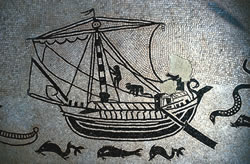
Rimini’s history begins from the beach. Up to 800,000 years ago, primitive man inhabited the coastal area as far back as the hillside of Covignano. From prehistorical times, the road to civilisation passed through the main evolutionary stages, taking Rimini to the forefront of the Roman era.
In 268 B.C. at the mouth of the Ariminus river, in an area that had previously been inhabited by the Etruscans, the Umbrians, the Greeks and the Gauls, the Romans founded the colony of Ariminum. It was seen as a bastion against invading Gauls and also as a trampoline for conquering the Padana plain. Rimini was a road junction with connections to central (Via Flaminia) and northern Italy (Via Emilia and Via Popilia) and it also opened up trade by sea and river.
The city was involved in the civil wars but remained faithful to the popular party and to its leaders, firstly Mario and then Caesar. After crossing the Rubicone, the latter made his legendary appeal to the legions in the Forum of Rimini.
Rimini, which gained the attention of many emperors in particular Augustus and Hadrian, was experiencing a great period in its history, embodied by the construction of prestigious monuments such as the Arch of Augustus, Tiberius Bridge and the Amphitheatre.
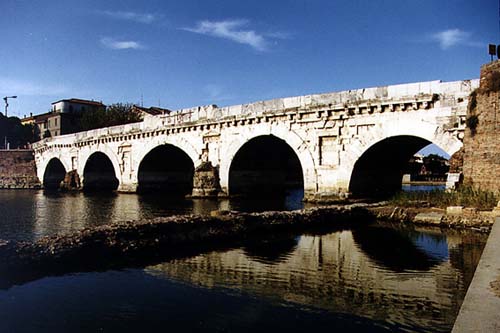
Crisis in the Roman world was marked by destruction caused by invasions and wars, but also by the testimony of the palaces of the Imperial officers and the first churches, the symbol of the spread of Christianity that held an important Council in Rimini in 359.
The city became a municipality in the fourteenth century and with the arrival of the religious orders, numerous convents and churches were built, providing work for many illustrious artists. In fact, Giotto inspired the fourteenth-century Rimini school, which was the expression of original cultural ferment.
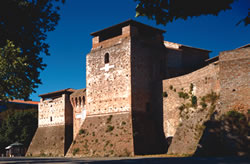
The Malatesta family, whose most famous member was Sigismondo Pandolfo, a commander and patron who was lord of Rimini between 1432 and 1468, emerged from the struggles between municipal factions.
At the beginning of the sixteenth century, once the Malatesta family had been banished, Rimini, which was now a small town of the Papal States, had a local government under the Apostolic Legate of Ravenna. Towards the end of the same century, the municipal square (Piazza Cavour), which had been closed off on a site where the Poletti Theatre was subsequently built, was redesigned. The statue of Pope Paul V has stood in the centre of the square next to the fountain since 1614.
In the sixteenth century, the 'grand square' (now known as 'Piazza Tre Martiri'), which was where markets and tournaments were held, underwent various changes. For example, a small temple dedicated to Sant’Antonio of Padua and the Clock Tower block were built, giving the square its present shape and size.
Until the eighteenth century, raiding armies, earthquakes, famines, floods and pirate attacks ravaged the city. In this gloomy situation and due to a weakened local economy, fishing took on great importance, a fact testified by the construction of functional structures such as the fish market and the lighthouse.
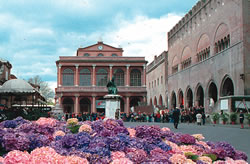
In 1797, Rimini along with the rest of Romagna was influenced by the passage of the Jacobean troops and became part of the Cisalpine Republic. The Napoleonic government suppressed the monastic orders, confiscating their property and thus dispersing a substantial heritage, and demolished many churches including the ancient cathedral of Santa Colomba. On 30th March 1815, Gioacchino Murat launched his proclamation to the Italian people from Rimini, inciting them to unity and independence.
An idea of what the city was like in the nineteenth century is provided by the palaces built along Corso d’Augusto and in particular by the theatre, which was designed by Luigi Poletti and succeeded in translating into Neoclassical form the ambitions of the ruling classes.
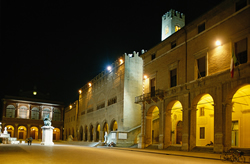
However, the biggest revolutionary element for the city was the foundation in 1843 of the first bathing establishment and the Kursaal, constructed to host sumptuous social events, became the symbol of tourist Rimini. In just a few years, the marina underwent considerable building work making Rimini 'the city of small villas'. At the beginning of the twentieth century, The Grand Hotel, the city’s first important accommodation facility, was built near the coast and soon became the emblem of a new kind of tourism.
During the Second World War, the city was torn apart by heavy bombardments and by the passage of the front along the Gothic Line but after liberation on 21st September 1944, impressive reconstruction work began, culminating in the explosive development of the tourist economy that created a new urban reality.
Monuments
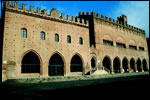
The Arengo and Podestà Palaces
Under the Arengo Palace’s portico, which dates from 1204, justice was administered and the municipal assembly met in the hall with multi-lancet windows situated on the first floor.
Next door, is the fourteenth century Podestà residence where the entrance is underlined by an arch with Malatesta symbols. Garampi Palace, which is now the municipal residence, was built at the end of the sixteenth century, modifying the façades of the Arengo and Podestà Palaces.
Following an earthquake in 1916, which brought to light remains of the medieval buildings, restoration work was carried out that redesigned the palaces in Neo-gothic style.
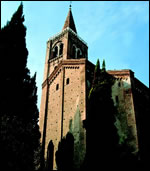
The church of San Giovanni Evangelista
(known as Sant’Agostino church)
The Agostiniani built the church, which is rectangular-shaped with an apse and two side chapels, in the thirteenth century. The decorations that remain in part consist of frescoes and a wooden crucifix attributed to the fourteenth century Rimini school of art.
In the eighteenth century, Ferdinando Bibiena modified the façades and the interior, which was enriched with stuccoes and frescoes by Vittorio Maria Bigari. The fourteenth-century painting was actually hidden and only came to light in 1916 following an earthquake. The Giudizio universale, which is on the triumphal arch, was removed in 1926 and is now housed in the Municipal Museum.
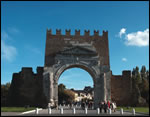
The Arch of Augustus
As its inscription declares, the arch was built in 27 B.C. as an honorary gate to celebrate Octavian Augustus. It once formed part of the stone-built city walls, the remains of which are still visible, but is now isolated because the adjacent structures were demolished in the 1930’s.
The structure, which was originally topped by a parapet bearing a statue of the Emperor, is richly decorated with religious and political references. In fact, the divinities represented in the round shields (Jupiter, Apollo, Neptune and Rome) recall the grandeur of Rome and of Augustus himself.

The Malatesta Temple
Giotto decorated the Temple, which was built on the site of the 13th century church of San Francesco, and indeed one of his wooden crucifixes is still housed inside. It was conceived by Sigismondo Pandolfo Malatesta as a memorial tomb for his family and although building work began in 1447 it was still incomplete on his death. The temple was designed by Leon Battista Alberti and Matteo dei Pasti and Agostino di Duccio created the bas-relief decorations in the chapels, which highlight the dominant personality of the commissioner who was celebrated by Piero della Francesca in his fresco of the prince and San Sigismondo.
The temple, which was recently consecrated a basilica, has undergone restoration work financed by the Cassa di Risparmio di Rimini Foundation. Its completion, in Jubilee year, returned the marble and bright colours of the interior chapels to their former splendour.
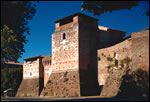
Castel Sismondo or Malatesta Fortress
Building work on Sigismondo Malatesta’s residence-fortress began in 1437 and lasted around 15 years. Today, unfortunately only the central nucleus remains. The castle appears on numerous Malatesta medals as well as on Piero della Francesca’s fresco in the Malatesta Temple where it is depicted with towers, walls, a wide moat and an imposing keep.
On the inscription at the entrance, Sigismondo claims responsibility for the building ex fundamentis, but it actually incorporated several older buildings. In the 17th century, the building became a Papal fortress and was then used as a prison until 1967. Nowadays, it is the prestigious venue for numerous cultural events.
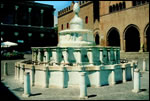
Pigna Fountain
The heart of medieval Piazza Cavour is the fountain, which also features in the painting of the city housed in the Malatesta Temple. Even Leonardo da Vinci was enchanted by the harmony of the waterspouts when he passed through Rimini in 1502.
Giovanni Carrari from Bergamo restored it after damage caused in 1540 by fireworks placed in the tub to celebrate a high prelate lending it its present shape, which respects the original ancient layout. A statue of Saint Paul once crowned the fountain but was replaced in the nineteenth century by the 'Pigna' (pine cone) that gives the fountain its name.

Tiberius Bridge
As the inscription on the internal parapets recalls, work on the bridge over the Marecchia River, then known as Ariminus, began under the Emperor Augustus in 14 A.D. and was completed under Tiberius in 21 A.D. The bridge still connects the city centre to Borgo San Giuliano and leads to the consular roads Via Emilia and Via Popilia that lead north.
Built in Istria stone, the bridge consists of five arches that rest on massive pillars with breakwater spurs set at an oblique angle with respect to the bridge’s axis in order to follow the current. The bridge’s structure on the other hand, rests on a practical system of wooden poles.

The Amphitheatre
The Amphitheatre, which dates from the second century as a coin of the Emperor Hadrian found buried in the walls testifies, was situated close to where the coast once was. It was originally a sombre brick structure, consisting of two superimposed orders with a colonnade of 60 arches. It was an extremely impressive sight, particularly when approaching from the sea. The Amphitheatre was elliptical-shaped and measured 117.7 x 88 metres while the arena was 73 x 44 metres wide, almost the same as those found in the great amphitheatres. Gladiatorial events held here drew at least 15,000 spectators at a time.